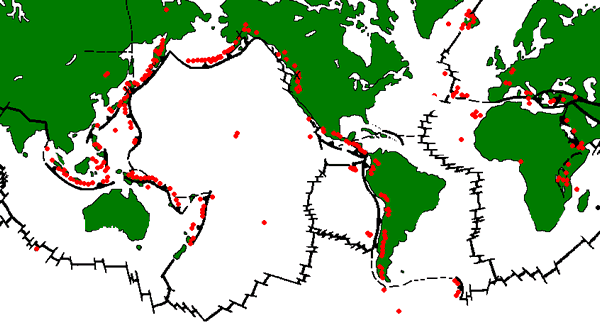BACKGROUND:
In the Pre Lab, students learned that there are 3
basic types of volcanoes. Cinder cones make a structure from cinders; shield
volcanoes are generally made from lava; and composite volcanoes are composed
of layers of cooled lava and ash.

Ring of Fire
In this lab, students plot the locations of examples
of all three types of volcanoes on a world map to see if there is a global
pattern. The students should be somewhat familiar with terms like,"the
Ring of Fire," the circum-Pacific area where volcanoes are more
prevalent than in other areas. They should also have a feeling for where the
volcanoes occur within this area. In North, Central, and South America the
volcanoes occur on the west coast of each country. In Alaska and the Asian
mainland, the volcanoes are located more along the southern edges of the
land. In Japan, Indonesia, and other parts of the South Pacific the
volcanoes are on the eastern side of the countries. In the lab, the students
will not be able to see the exact location of the volcano, so they must put
a dot in its general location.
PROCEDURE:
- Review the three types of volcanoes, and any other terminology that
you feel is necessary.
- Tell the students that they will be using a globe or map to plot the
different types of volcanoes on the map. Have them blow up the globes if
they are using them.
- Instruct them to put the number of the volcano on a stick-on dot, and
to plot the location of the volcano on the globe or placemat.
- Ask the students if there is a visible pattern in the locations of the
three types of volcanoes, or if they are randomly dispersed. The answer
is no, the 3 different types of volcanoes have no pattern. The only
pattern is that many volcanoes occur along the "Ring of Fire"
in the Pacific Ocean.
- A map which shows the locations of the volcanoes in the lab is on the
next page. Use this to guide the studentsí answers.
|